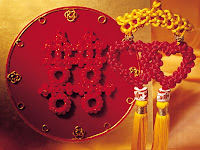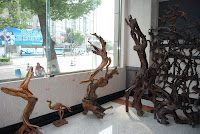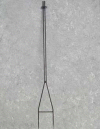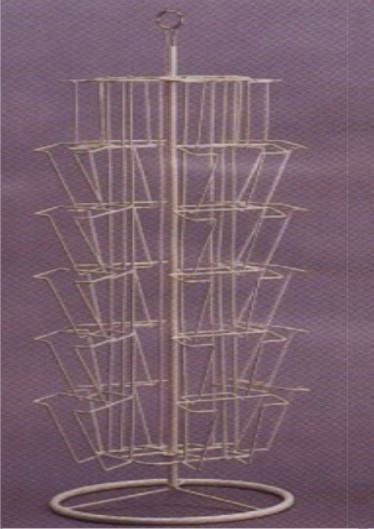What animal sign were you born under?Legend
According to Chinese legend, the twelve animals quarreled one day as to who was to head the cycle of years। The gods were asked to decide and they held a contest: whoever was to reach the opposite bank of the river would be first, and the rest of the animals would receive their years according to their finish.
All the twelve animals gathered at the river bank and jumped in। Unknown to the ox, the rat had jumped upon his back. As the ox was about to jump ashore, the rat jumped off the ox's back, and won the race. The pig, who was very lazy, ended up last. That is why the rat is the first year of the animal cycle, the ox second, and the pig last.
Zodiac Chart:
The rotating cycle of twelve animal signs was a folk method for naming the years in traditional China। The animal signs for one another in an established order, and are repeated every twelve years. 1976 was the Year of the Dragon, and 1977 was the year of the Snake.
Rat charm:1912, 1924, 1936, 1948, 1960, 1972, 1984, 1996
People born in the Year of the Rat are noted for their charm and attraction for the opposite sex। They work hard to achieve their goals, acquire possessions, and are likely to be perfectionists. They are basically thrifty with money. Rat people are easily angered and love to gossip. Their ambitions are big, and they are usually very successful. They are most compatible with people born in the years of the Dragon, Monkey, and Ox.
Ox patient:1913, 1925, 1937, 1949, 1961, 1973, 1985, 1997
People born in the Year of the Ox are patient, speak little, and inspire confidence in others। They tend, however, to be eccentric, and bigoted, and they anger easily. They have fierce tempers and although they speak little, when they do they are quite eloquent. Ox people are mentally and physically alert. Generally easy-going, they can be remarkably stubborn, and they hate to fail or be opposed. They are most compatible with Snake, Rooster, and Rat people.Tiger sensitive:1914, 1926, 1938, 1950, 1962, 1974, 1986, 1998
Tiger people are sensitive, given to deep thinking, capable of great sympathy। They can be extremely short-tempered, however. Other people have great respect for them, but sometimes tiger people come into conflict with older people or those in authority. sometimes Tiger people cannot make up their minds, which can result in a poor, hasty decision or a sound decision arrived at too late. They are suspicious of others, but they are courageous and powerful. Tigers are most compatible with Horses, Dragons, and Dogs 。
Rabbit articulate:1915, 1927, 1939, 1951, 1963, 1975, 1987, 1999
People born in the Year of the Rabbit are articulate, talented, and ambitious। They are virtuous, reserved, and have excellent taste. Rabbit people are admired, trusted, and are often financially lucky. They are fond of gossip but are tactful and generally kind. Rabbit people seldom lose their temper. They are clever at business and being conscientious, never back out of a contract. They would make good gamblers for they have the uncanny gift of choosing the right thing. However, they seldom gamble, as they are conservative and wise. They are most compatible with those born in the years of the Sheep, Pig, and Dog.
Dragon healthy:1916, 1928, 1940, 1952, 1964, 1976, 1988, 2000
People born in the Year of the Dragon are healthy, energetic, excitable, short-tempered, and stubborn। They are also honest, sensitive, brave, and they inspire confidence and trust. Dragon people are the most eccentric of any in the eastern zodiac. They neither borrow money nor make flowery speeches, but they tend to be soft-hearted which sometimes gives others an advantage over them. They are compatible with Rats, Snakes, Monkeys, and Roosters.
Snake deep:1917, 1929, 1941, 1953, 1965, 1977, 1989, 2001
People born in the Year of the Snake are deep। They say little and possess great wisdom. They never have to worry about money; they are financially fortunate. Snake people are often quite vain, selfish, and a bit stingy. Yet they have tremendous sympathy for others and try to help those less fortunate. Snake people tend to overdo, since they have doubts about other people's judgment and prefer to rely on themselves. They are determined in whatever they do and hate to fail. Although calm on the surface, they are intense and passionate. Snake people are usually good-looking and sometimes have marital problems because they are fickle. They are most compatible with the Ox and Rooster.
Horse popular:1918, 1930, 1942, 1954, 1966, 1978, 1990, 2002
People born in the Year of the Horse are popular। They are cheerful, skillful with money, and perceptive, although they sometimes talk too much. The are wise, talented, good with their hands, and sometimes have a weakness for members of the opposite sex. They are impatient and hot-blooded about everything except their daily work. They like entertainment and large crowds. They are very independent and rarely listen to advice. They are most compatible with Tigers, Dogs, and Sheep.
Goat elegant:1919, 1931, 1943, 1955, 1967, 1979, 1991, 2003
People born in the Year of Ram are elegant and highly accomplished in the arts। They seem to be, at first glance, better off than those born in the zodiac's other years. But ram year people are often shy, pessimistic, and puzzled about life. They are usually deeply religious, yet timid by nature. Sometimes clumsy in speech, they are always passionate about what they do and what they believe in. Ram people never have to worry about having the best in life for their abilities make money for them, and they are able to enjoy the creature comforts that they like. Ram people are wise, gentle, and compassionate. They are compatible with Rabbits, Pigs, and Horses.
Monkey clever:1920, 1932, 1944, 1956, 1968, 1980, 1992, 2004
People born in the Year of the Monkey are the erratic geniuses of the cycle। Clever, skillful, and flexible, they are remarkably inventive and original and can solve the most difficult problems with ease. There are few fields in which Monkey people wouldn't be successful but they have a disconcerting habit of being too agreeable. They want to do things now, and if they cannot get started immediately, they become discouraged and sometimes leave their projects. Although good at making decisions, they tend to look down on others. Having common sense, Monkey people have a deep desire for knowledge and have excellent memories. Monkey people are strong willed but their anger cools quickly. They are most compatible with the Dragon and Rat. Rooster deep thinkers:1921, 1933, 1945, 1957, 1969, 1981, 1993, 2005
People born in the Year of the Rooster are deep thinkers, capable, and talented। They like to be busy and are devoted beyond their capabilities and are deeply disappointed if they fail. People born in the Rooster Year are often a bit eccentric, and often have rather difficult relationship with others. They always think they are right and usually are! They frequently are loners and though they give the outward impression of being adventurous, they are timid. Rooster people¡¦s emotions like their fortunes, swing very high to very low. They can be selfish and too outspoken, but are always interesting and can be extremely brave. They are most compatible with Ox, Snake, and Dragon. Dog loyalty:1922, 1934, 1946, 1958, 1970, 1982, 1994, 2006
People born in the Year of the Dog possess the best traits of human nature। They have a deep sense of loyalty, are honest, and inspire other people¡¦s confidence because they know how to keep secrets. But Dog People are somewhat selfish, terribly stubborn, and eccentric. They care little for wealth, yet somehow always seem to have money. They can be cold emotionally and sometimes distant at parties. They can find fault with many things and are noted for their sharp tongues. Dog people make good leaders. They are compatible with those born in the Years of the Horse, Tiger, and Rabbit.
Pig chivalrous:1923, 1935, 1947, 1959, 1971, 1983, 1995, 2007
People born in the Year of the Pig are chivalrous and gallant. Whatever they do, they do with all their strength. For Boar Year people, there is no left or right and there is no retreat. They have tremendous fortitude and great honesty. They don't make many friends but they make them for life, and anyone having a Boar Year friend is fortunate for they are extremely loyal. They don't talk much but have a great thirst for knowledge. They study a great deal and are generally well informed. Boar people are quick tempered, yet they hate arguments and quarreling. They are kind to their loved ones. No matter how bad problems seem to be, Boar people try to work them out, honestly if sometimes impulsively. They are most compatible with Rabbits and Sheep.





 Traditional Chinese decorative knots, also known as Chinese knots, are typical local arts of China. They are a distinctive and traditional Chinese folk handicraft woven separately from one piece of thread and named according to its shape and meaning. In Chinese, "knot" means reunion, friendliness, peace, warmth, marriage, love, etc. Chinese knots are often used to express good wishes, including happiness, prosperity, love and the absence of evil.Chinese people have known how to tie knots using cords ever since they began learned how to attach animal pelts to their bodies to keep warm thousands of years ago. As civilization advanced, Chinese people used knots for more than just fastening and wrapping. Knots were also used to record events, while others had a purely ornamental function. In 1980, dedicated connoisseurs collected and arranged decorative yet practical knots passed down over centuries in China. After studying the structures of these knots, the devotees set about creating new variations and increasing the decorative value of knots. The exquisitely symmetrical knots that come in so many forms are as profound as the great cultural heritage of the Chinese people.The Chinese knot is based on over a dozen basic knots named according to their distinctive shapes, usages, or origins. The Two-Coins Knot, for example, is shaped like two overlapping coins once used in ancient China. The Button Knot functions as a button, and the Reversed Swastika Knot was derived from the Buddhist symbol commonly seen on the streamers hanging down from the waistband of the Buddhist Goddess of Mercy.The knots are pulled tightly together and are sturdy enough to be used for binding or wrapping, making them very practical. Furthermore, the complicated structure of the Chinese knot allows all kinds of variations and enhances its decorative value. Almost all basic Chinese knots are symmetrical, which has set certain technical limitations on the design and creation of new patterns and themes. Symmetry is consistent with time-honored ornamental and aesthetic standards in China. Visually, the symmetrical designs are more easily accepted and appreciated by Chinese people.Except for the Two-Coins Knot, the Chinese knot is three dimensional in structure. It comprises two planes tied together leaving a hollow center. Such a structure lends rigidity to the work as a whole and keeps its shape when hung on the wall. The hollow center also allows for the addition of precious stones.Crafting the Chinese knot is a three-step process which involves tying knots, tightening them and adding the finishing touches. Knot-tying methods are fixed, but the tightening can determine the degree of tension in a knot, the length of loops (ears) and the smoothness and orderliness of the lines. Thus, how well a Chinese knot has been tightened can demonstrate the skill and artistic merit of a knot artist. Finishing a knot means inlaying pearls or other precious stones, starching the knot into certain patterns, or adding any other final touches.Since ancient times, the Chinese knot has adorned both the fixtures of palace halls and the daily implements of countryside households. The Chinese Macrame has also appeared in paintings, sculptures and other pieces of folk art. For instance, the Chinese Macrame was used to decorate chairs used by the emperor and empress, corners of sedans, edges of parasols, streamers attached to the waistbands of lady's dresses, as well as all manners of seals, mirrors, pouches, sachets, eyeglass cases, fans and Buddhist rosaries.The endless variations and elegant patterns of the Chinese knot, as well as the multitude of different materials that can be used (cotton, flax, silk, nylon, leather and precious metals, such as gold and silver, to name a few) have expanded the functions and widened the applications of the Chinese knot. Jewelry, clothes, gift-wrapping and furniture can be accentuated with unique Chinese knot creations. Large Chinese knot wall hangings have the same decorative value as fine paintings or photographs, and are perfectly suitable for decorating a parlor or study.The Chinese knot, with its classic elegance and ever-changing variations, is both practical and ornamental, fully reflecting the grace and depth of Chinese culture.
Traditional Chinese decorative knots, also known as Chinese knots, are typical local arts of China. They are a distinctive and traditional Chinese folk handicraft woven separately from one piece of thread and named according to its shape and meaning. In Chinese, "knot" means reunion, friendliness, peace, warmth, marriage, love, etc. Chinese knots are often used to express good wishes, including happiness, prosperity, love and the absence of evil.Chinese people have known how to tie knots using cords ever since they began learned how to attach animal pelts to their bodies to keep warm thousands of years ago. As civilization advanced, Chinese people used knots for more than just fastening and wrapping. Knots were also used to record events, while others had a purely ornamental function. In 1980, dedicated connoisseurs collected and arranged decorative yet practical knots passed down over centuries in China. After studying the structures of these knots, the devotees set about creating new variations and increasing the decorative value of knots. The exquisitely symmetrical knots that come in so many forms are as profound as the great cultural heritage of the Chinese people.The Chinese knot is based on over a dozen basic knots named according to their distinctive shapes, usages, or origins. The Two-Coins Knot, for example, is shaped like two overlapping coins once used in ancient China. The Button Knot functions as a button, and the Reversed Swastika Knot was derived from the Buddhist symbol commonly seen on the streamers hanging down from the waistband of the Buddhist Goddess of Mercy.The knots are pulled tightly together and are sturdy enough to be used for binding or wrapping, making them very practical. Furthermore, the complicated structure of the Chinese knot allows all kinds of variations and enhances its decorative value. Almost all basic Chinese knots are symmetrical, which has set certain technical limitations on the design and creation of new patterns and themes. Symmetry is consistent with time-honored ornamental and aesthetic standards in China. Visually, the symmetrical designs are more easily accepted and appreciated by Chinese people.Except for the Two-Coins Knot, the Chinese knot is three dimensional in structure. It comprises two planes tied together leaving a hollow center. Such a structure lends rigidity to the work as a whole and keeps its shape when hung on the wall. The hollow center also allows for the addition of precious stones.Crafting the Chinese knot is a three-step process which involves tying knots, tightening them and adding the finishing touches. Knot-tying methods are fixed, but the tightening can determine the degree of tension in a knot, the length of loops (ears) and the smoothness and orderliness of the lines. Thus, how well a Chinese knot has been tightened can demonstrate the skill and artistic merit of a knot artist. Finishing a knot means inlaying pearls or other precious stones, starching the knot into certain patterns, or adding any other final touches.Since ancient times, the Chinese knot has adorned both the fixtures of palace halls and the daily implements of countryside households. The Chinese Macrame has also appeared in paintings, sculptures and other pieces of folk art. For instance, the Chinese Macrame was used to decorate chairs used by the emperor and empress, corners of sedans, edges of parasols, streamers attached to the waistbands of lady's dresses, as well as all manners of seals, mirrors, pouches, sachets, eyeglass cases, fans and Buddhist rosaries.The endless variations and elegant patterns of the Chinese knot, as well as the multitude of different materials that can be used (cotton, flax, silk, nylon, leather and precious metals, such as gold and silver, to name a few) have expanded the functions and widened the applications of the Chinese knot. Jewelry, clothes, gift-wrapping and furniture can be accentuated with unique Chinese knot creations. Large Chinese knot wall hangings have the same decorative value as fine paintings or photographs, and are perfectly suitable for decorating a parlor or study.The Chinese knot, with its classic elegance and ever-changing variations, is both practical and ornamental, fully reflecting the grace and depth of Chinese culture. 






























.jpg)















